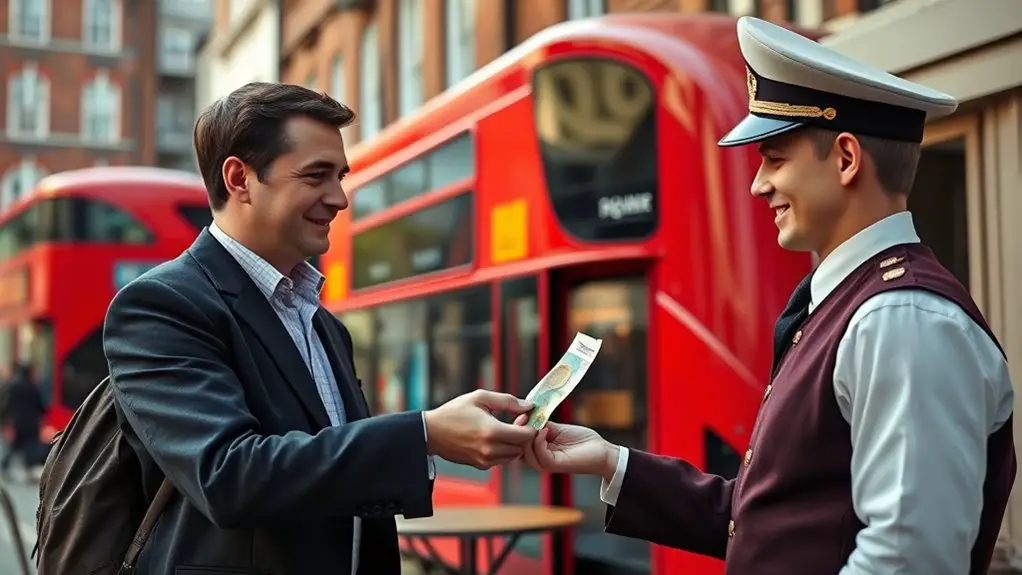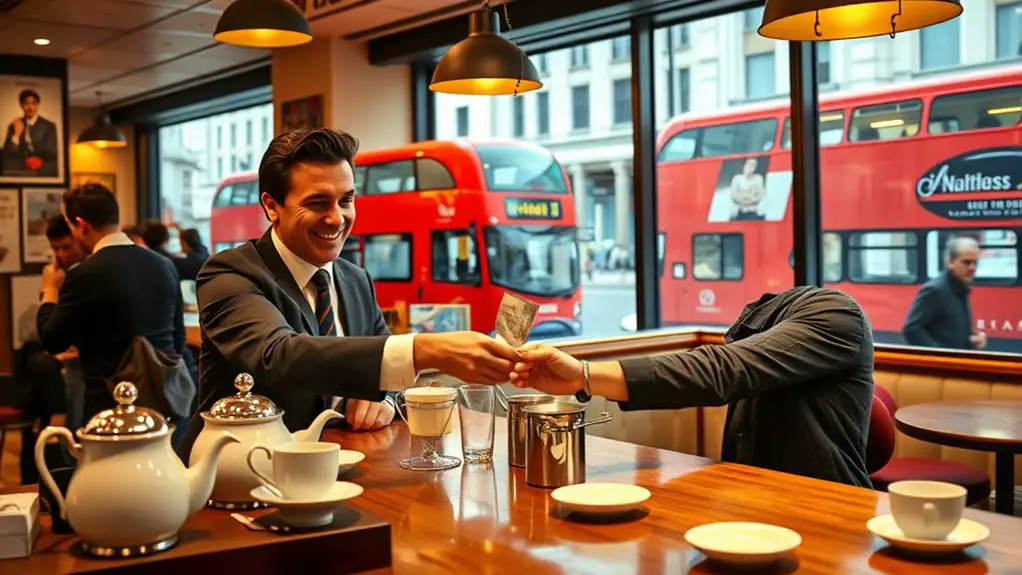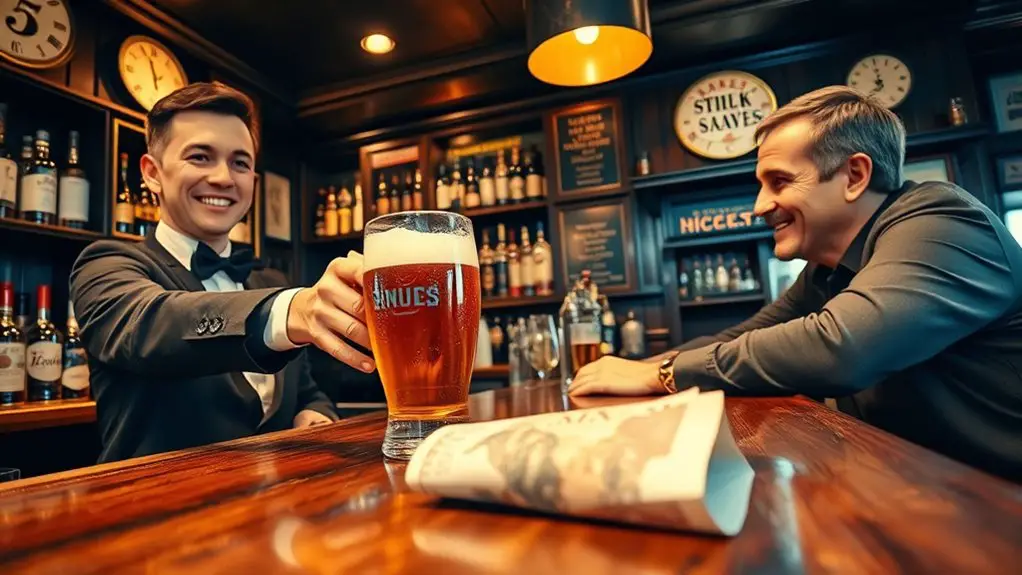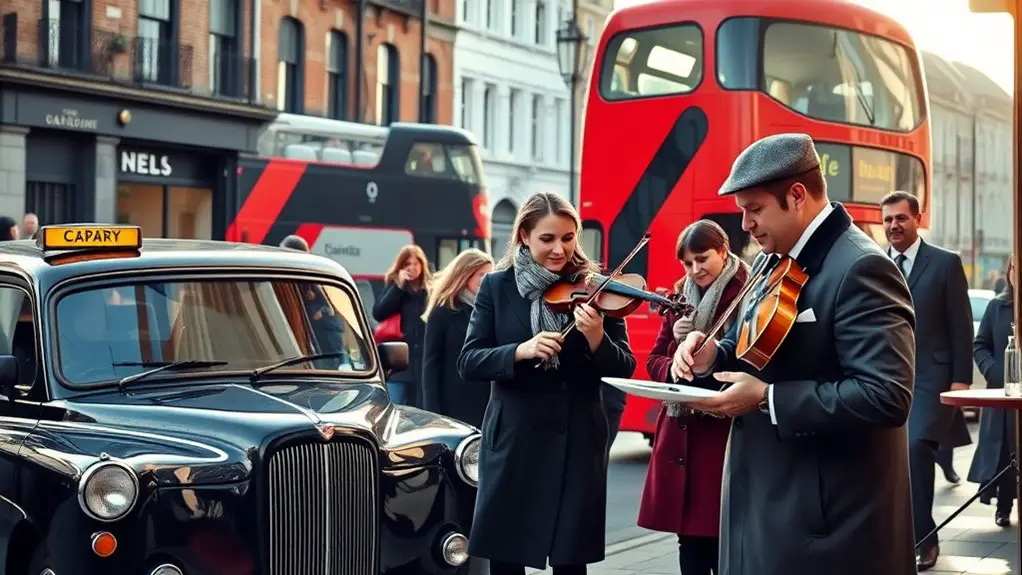In London, tipping is a polite gesture rather than an obligation, with modest amounts appreciated across services. In restaurants, leaving 10-15% of the bill is common, but check if gratuity’s included. For taxis and hotels, small tips—like rounding up fares or leaving a few pounds—are customary. Tipping guides, delivery staff, and beauty professionals around 10% shows appreciation. If you’re curious about specific services or situations, more details will help you navigate London’s subtle tipping etiquette smoothly.
Key Takeaways
- Tipping is customary but not obligatory; 10-15% in restaurants and small tips for hotel staff are appreciated.
- Check if service charges are included before tipping at restaurants or cafés.
- Tip taxi drivers around 10-15% of the fare and consider rounding up for good service.
- For hotel staff, tip £2-£5 daily for housekeeping and £1-£2 per bag for porters.
- Tipping for tours, delivery, and beauty services generally ranges from 10-15%, with discretion based on service quality.
General Tipping Customs in London

While tipping in London isn’t always obligatory, understanding the local customs can help you navigate service interactions smoothly.
The history of tipping in London reflects broader cultural differences, where tipping was once seen as a sign of appreciation for exceptional service rather than an expectation.
Today, tipping practices vary across industries, but generally, a small gratuity is appreciated. For example, in taxis, rounding up the fare or giving about 10% is common, while hotel staff like porters often receive a couple of pounds per bag.
Recognizing that cultural differences influence tipping customs is key to respectful engagement. Unlike some countries where tipping is mandatory, in London, it’s more about courtesy and acknowledgment of good service.
Being aware of these nuances guarantees you won’t under- or over-tip, helping you enjoy your experience while honoring local etiquette.
Tipping in Restaurants and Cafés

When dining out in London, knowing how much to tip and when to do so can enhance your experience.
Typically, leaving around 10-15% of the bill is standard, but it’s also common to round up or leave small change for good service.
Pay attention to the bill—sometimes tips are included, and understanding the timing for tipping helps you show appreciation appropriately.
Typical Tip Amounts
In London, tipping in restaurants and cafés typically ranges from 10% to 15% of the bill if the service is satisfactory. This reflects the city’s established tipping culture, where gratuity expectations are generally understood but not always obligatory.
If the service exceeds your expectations, consider tipping toward the higher end of this range or rounding up the bill. For smaller cafes or casual eateries, rounding up the total or leaving a couple of pounds is appreciated.
When to Tip
Knowing the right moment to leave a tip can enhance your dining experience and guarantee you’re respectful of local customs.
Tipping history in London reflects a gradual shift from mandatory service charges to voluntary gestures, influenced by cultural differences. Typically, you should tip after you’ve received your bill and finished your meal, especially if the service met or exceeded your expectations.
If you’re paying by card, it’s common to add the tip directly on the payment terminal; cash tips are appreciated but not obligatory. Be attentive to cues from your server—if they’ve been attentive and friendly, tipping is appropriate.
Understanding these nuances assures your tip aligns with local practices and shows your appreciation without overstepping cultural boundaries.
Paying the Bill
Paying the bill is a straightforward yet important part of the dining experience in London, and understanding local tipping customs can guarantee you leave the right amount.
When the bill arrives, check if a service charge has already been included, which is common in many restaurants; if so, additional tipping isn’t necessary unless you received exceptional service.
If no service charge appears, it’s customary to leave a tip of around 10-15% of the total bill. If you’re splitting the bill with friends, consider the service charges and how the amount is divided.
In cafés or casual spots where service isn’t included, rounding up the total or leaving a few extra pounds is appreciated.
Always make certain your tip is discreetly handed over or added to the payment, respecting local etiquette.
Tipping at Pubs and Bars

When it comes to tipping at pubs and bars, understanding the typical amounts and timing can make your experience smoother.
You might wonder whether to leave cash or add the tip to your card, especially during busy nights. Knowing the local customs helps you show appreciation without overdoing it.
Typical Tipping Amounts
In London pubs and bars, tipping typically ranges from a few pounds to about 10% of your bill, depending on the service quality.
Understanding tipping history and cultural differences helps clarify expectations—while tipping isn’t mandatory, it’s appreciated for good service.
Historically, tipping in the UK was less common than in countries like the US, but recent trends show more consistent gratuities, especially in busy or upscale venues.
If you receive attentive service or a bartender goes above and beyond, consider leaving a pound or two per drink or rounding up the bill.
For larger groups or exceptional service, tipping closer to 10% isn’t unusual.
Being aware of these customary amounts guarantees your tip aligns with local etiquette without overdoing it.
When to Tip
Knowing the appropriate moments to tip at pubs and bars guarantees your gratuity feels natural and considerate. Many tourists hold tipping misconceptions, thinking you must tip after every drink or round, but that’s not always necessary.
Typically, it’s best to tip when you’ve received exceptional service or settle your bill. Cultural differences also influence expectations; in London, tipping for drinks isn’t obligatory, but a small tip—around 10% or rounding up—is appreciated.
Watch for cues from staff—if they’ve gone above and beyond or you’re part of a larger group, tipping becomes more appropriate. Remember, tipping at bars isn’t about obligation but about showing appreciation for attentive service.
Being mindful of these moments helps you tip appropriately without overdoing it or seeming out of place.
Cash vs. Card Tips
Deciding whether to tip with cash or card at pubs and bars in London can influence how your gratuity is received and processed.
If you have cash preferences, tipping directly with cash guarantees your tip goes straight to the staff immediately, which many appreciate.
Conversely, card tips offer greater convenience, especially if you prefer not to carry cash or want a seamless payment experience. Many establishments now enable card tips to be added during the transaction or at the point of sale, making it quick and easy.
Keep in mind that tipping via card might sometimes delay the gratuity reaching staff, depending on the venue’s payment system.
Ultimately, choose what suits your comfort—cash for immediacy or card for convenience—while respecting local customs.
Tipping for Hotel Services
When staying at a hotel in London, tipping hotel staff shows appreciation for their service and can enhance your overall experience. For exceptional help from the hotel concierge, consider tipping around £5 to £10 for personalized assistance like booking reservations or arranging transportation. If you order room service, tip 10-15% of the bill, or a few pounds for smaller orders. Housekeepers appreciate a daily tip of about £2-£5, left in the room each morning. Bellhops or porters should receive around £1-£2 per bag. Here’s a visual to help you picture the scene:
| Service | Typical Tip | When to Tip |
|---|---|---|
| Hotel Concierge | £5-£10 | When they assist with reservations |
| Room Service | 10-15% | After delivery |
| Housekeeping | £2-£5/day | Daily, at your discretion |
Tipping thoughtfully guarantees friendly service and a more memorable stay.
Tipping for Taxi and Rideshare Drivers
When it comes to tipping taxi and rideshare drivers in London, understanding standard practices helps guarantee you’re respectful and fair.
You should consider how much to tip based on the quality of service, with most passengers rounding up or leaving around 10%.
Additionally, you can use the app’s tipping feature or give extra for exceptional service or assistance with luggage.
Standard Tipping Practices
In London, tipping taxi and rideshare drivers is a common way to show appreciation for their service, and understanding the standard practices can help you avoid awkward situations.
Many travelers have tipping misconceptions, believing it’s always optional or that a small change suffices. In reality, tipping around 10-15% of the fare is customary, especially if the driver offers exceptional service or helps with luggage.
Cultural differences influence tipping norms, so don’t assume practices from your home country apply here. When paying in cash, round up to the nearest pound or add a couple of pounds.
For card payments, leaving a tip through the app or directly handing over cash guarantees your appreciation is clear. Being aware of these practices helps you navigate London’s tipping culture smoothly.
Rideshare Tipping Options
Wondering how to tip your rideshare or taxi driver in London? Many rideshare apps feature options to tip directly within the app, making it quick and convenient.
Typically, after your trip ends, you’ll see a prompt to add a tip—usually a percentage of the fare or a custom amount. The driver rating system in these apps encourages good service, and tipping can positively influence your driver’s rating.
While tipping isn’t mandatory, a tip of around 10% to 15% is appreciated if you’re satisfied with the ride. Some apps allow cash tips if you prefer, but digital tips are increasingly common.
Keep in mind, tipping not only rewards good service but also supports drivers in a gig economy.
When to Tip Extra
Generally, tipping extra is appropriate when your ride exceeds expectations or involves special circumstances.
In London, the tipping culture comparison shows that while tipping isn’t always expected, a generous tip reflects appreciation for exceptional service. If your driver offers helpful local advice, navigates challenging traffic smoothly, or provides a friendly, professional attitude, consider tipping more.
Service quality influence plays a key role here: high-quality, attentive service warrants an additional tip, whereas average service might not. For rideshare or taxi journeys, tipping around 10-15% of the fare is customary for outstanding service.
Tipping Hairdressers and Beauty Professionals
When you visit a hairdresser or beauty professional in London, tipping is a thoughtful way to show appreciation for their skill and service.
For hairdresser services, it’s customary to tip around 10% of the total bill, especially if you’re satisfied with the haircut or styling.
If you receive multiple beauty treatments—such as facials, manicures, or massages—consider tipping each provider directly, typically 10-15% of the cost.
Some salons include gratuity in their prices, so check your bill first.
For exceptional service, tipping more is appreciated but not obligatory.
When paying, it’s best to tip in cash directly to the professional, ensuring they receive it personally.
Keep in mind that tipping is a gesture of gratitude, not a requirement, but it’s appreciated as recognition of their craftsmanship and attentive care.
Being considerate with your tip helps maintain good relationships and encourages excellent service in the future.
Tipping for Tour Guides and Excursions
Tipping for tour guides and excursions in London is a meaningful way to acknowledge their expertise and enhance your experience.
Tipping guides in London shows appreciation and helps make your experience more memorable.
Whether you’re joining a private tour or a group excursion, tips reflect your appreciation for their knowledge and effort. Generally, tipping 10-15% of the tour cost is appropriate, but it’s customary to adjust based on the quality of service.
For private tours, where the guide offers personalized attention, consider tipping a bit more—around £10-£20 per person. For group excursions, a tip of £2-£5 per person is typical, especially if the guide provides engaging insights.
Keep in mind that some tour companies include gratuities in their fees, so check ahead. Being attentive to the guide’s enthusiasm, professionalism, and local expertise will help you decide the right amount.
Tipping thoughtfully guarantees you support guides who make your London adventure memorable.
Tipping for Delivery and Takeaway Services
Ever wondered how much to tip when ordering food for delivery or takeaway in London? Delivery etiquette suggests tipping between 10-15% of your bill, especially if the service is prompt and courteous.
If the delivery person faces bad weather or long distances, consider tipping on the higher end as a gesture of appreciation.
For takeaway services, tipping isn’t always expected but is appreciated, particularly if staff go above and beyond, like packing special dietary items or offering quick service.
In some cases, a small cash tip directly to the delivery person is preferred, as they often rely on tips for their income.
If paying by card, check if the terminal prompts for a tip—adding a percentage or a fixed amount shows your gratitude.
Tipping in Other Service Sectors
In various service sectors across London, understanding proper tipping practices can enhance your experiences and show appreciation for quality service. Tipping cultural differences exist beyond restaurants, so knowing the norms helps you avoid awkward situations.
Understanding tipping customs across London’s service sectors enhances your experience and ensures respectful interactions.
- Beauty and Spa Services: If you receive a massage or beauty treatment, tipping around 10% is customary. Some salons include service charges, so check your bill before tipping.
- Hotels and Concierge: For bellhops or concierge services, tip £1-£2 per bag or a few pounds for special assistance. Tipping reflects gratitude for personalized help.
- Transport Services: Tipping taxi or private drivers around 10-15% is standard, especially if they assist with luggage or provide excellent service. Show appreciation through thoughtful tipping, respecting local customs.
Being aware of service sector tipping and cultural differences guarantees respectful, positive interactions during your stay in London.
Recognizing When Tipping Is Not Necessary
While tipping is customary in many service interactions in London, there are situations where it’s not expected or necessary. Understanding tipping misconceptions and cultural differences can help you avoid over-tipping or appearing awkward.
For example, if you’re visiting a café or casual restaurant, a service charge may already be included in the bill, making extra tipping unnecessary. Similarly, in self-service venues or fast-food outlets, tipping isn’t customary.
If you receive exceptional service from a hotel concierge or taxi driver, tipping is appreciated but not obligatory—sometimes a simple thank you suffices. It’s important to recognize that in the UK, tipping practices differ from other countries; in some cultures, tipping is more formalized, while in London, modest tips are often enough.
When in doubt, observe what locals do or ask discreetly. Being aware of these nuances guarantees you show appreciation appropriately without overstepping local etiquette.
Frequently Asked Questions
Do I Need to Tip for Public Transportation Services?
You generally don’t need to tip for public transport services in London, as fare prices cover the costs.
However, if you ride a taxi or private hire vehicle, tipping for taxis is appreciated but not obligatory.
Public transport etiquette suggests that rounding up fares or giving small tips for exceptional service is thoughtful.
Is Tipping Customary at Street Food Vendors?
Tipping at street food vendors in London isn’t customary, but you can show appreciation if the service exceeds your expectations.
Cultural differences often influence tipping habits, and in London, most people don’t tip at street stalls. If you do choose to tip, a small amount or round-up is appreciated.
Should I Tip for Baggage Handling at Airports?
You should tip baggage handlers at airports if they provide extra effort or assistance.
When collecting your luggage at baggage claim or passing through airport security, tipping is appreciated but not mandatory. A few pounds per bag is customary, especially if they help with heavy or multiple bags.
Your tip shows gratitude for their service and can make your airport experience smoother and friendlier.
How Much Should I Tip for a Spa Treatment?
For a spa treatment in London, you should tip around 10-15% of the service cost, aligning with local tipping etiquette and spa service standards.
If you’re happy with the experience, tipping at the higher end shows appreciation.
Always check if gratuity is included in the bill; if not, add your tip in cash or via card.
Your tip reflects your satisfaction and respects the professionalism of the staff.
Are Tips Expected for Sightseeing Bus Tours?
For sightseeing bus tours, tips aren’t strictly expected but are appreciated.
You should consider sightseeing bus tour tips of around 10-15% of the ticket price if you enjoyed the experience.
Guided tour gratuities are a nice gesture, especially if the guide was engaging and informative.
If you don’t tip, it’s not a big issue, but tipping shows your gratitude for their effort and enhances your overall experience.
Conclusion
Understanding London’s tipping etiquette helps you show appreciation appropriately without overdoing it. Remember, in many cases, rounding up or leaving a small tip suffices, especially in restaurants, pubs, and taxis. Be attentive to cues from service staff and check if service charges are included. By following these guidelines, you’ll enjoy seamless interactions and leave a positive impression, ensuring your visit feels respectful and culturally aware. Tipping thoughtfully enhances your experience and supports the local service industry.
